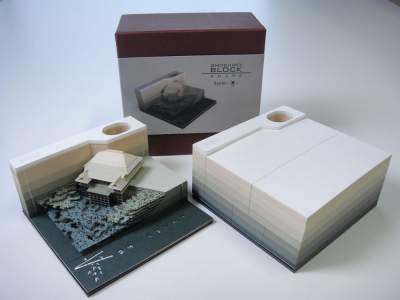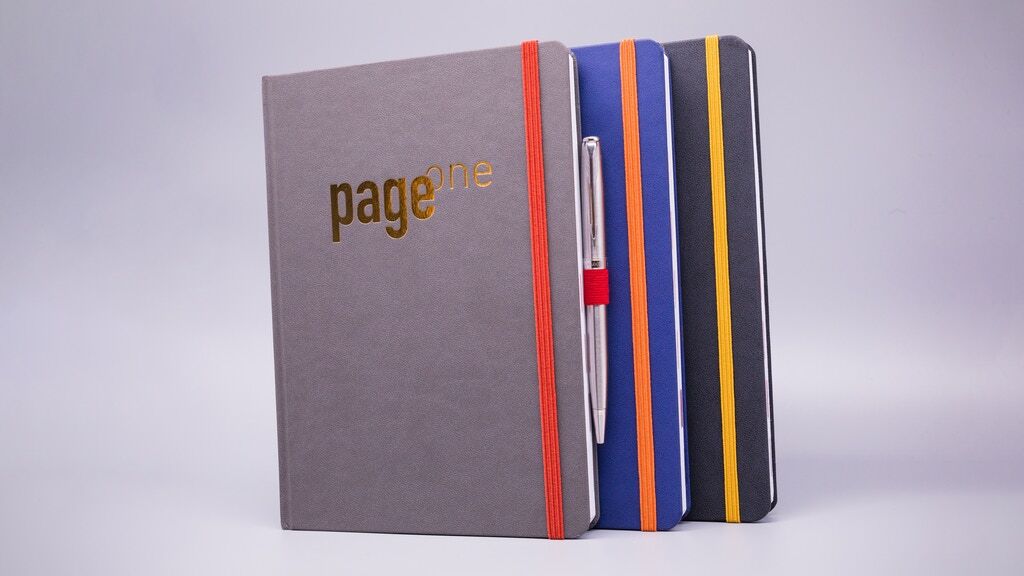It’s so nice to discover new notebook brands, especially ones that are committed to donating part of their proceeds to people in need. Lois Ho founded Pebble Stationery Co. in Perth, Western Australia and was able to fund her first project, a pocket notebook made with Tomoe River paper, in 24 hours. For each pack of notebooks they sell, Pebble Stationery donates a pencil to a child in need, and with the initial Kickstarter campaign, they provided 200 pencils to the Shree Annapurna Panchankanya Primary school in Nepal, which has been severely affected by the Earthquake in 2015.
Let’s take a look at the sample Lois sent me to review:

Exterior and Construction
The Pebble Stationery notebook comes in a two-pack. The notebooks are held together with a paper band with branding info on it, and then enclosed in a clear plastic envelope. The design of the packaging is clean and classy. The notebooks are grey with a subtle linen texture, and the Pebble Stationery name almost invisibly stamped on the cover. The endpapers inside are a pleasant surprise in a robin’s egg blue, with space to write contact information and notebook contents. And here’s a neat trick– from the outside, you can’t even see how they are bound! The cover is actually 2-ply, which allows the binding to be concealed.
Inside the notebook, ta-da! Here’s what that 2-ply binding is hiding: lovely blue stitching!

Each notebook has 80 pages of 52 GSM Tomoe River paper. They are amazingly slim compared to other staple or stitch-bound notebooks, such as the Field Notes Ambition and Women Artists in Paris notebooks seen with it below, each of which only has 48 pages.

My only quibble with the exterior of the notebook is that after opening it, the cover seems to curl slightly, so that the notebook doesn’t sit fully closed. I’ve had this happen to a few other notebooks– I think it is due to humidity causing uneven expansion of one layer of the cover, so it may vary with the weather, and daily use will probably curl it up a bit anyway. I don’t really consider this a defect or problem, as it doesn’t affect the function of the notebook, and if you use a notebook cover, it shouldn’t be an issue at all. It’s just a minor aesthetic thing that may bother some perfectionists!

Pen Tests
The paper is, of course, great. Tomoe River paper is always so smooth and lightweight, it is an absolute pleasure to write on. What I also love is the dot grid pattern, which is spaced at 4mm instead of the more typical 5mm. I have small handwriting so this is a very comfortable size for me. The color of the paper is a cool bright white.
Tomoe River paper is known for performing well with fountain pens. All my inks produced a nice sharp line with no feathering, and colors look vibrant. None of my fountain pens bled through except for my vintage Waterman, which is rather scratchy, so the pressure of flexing the nib always seems to rip the paper fibers a bit. A few other wet pens bled slightly, but much less than on most other papers. Because the paper is so thin, there is more show-through than average, so whether you’ll want to write on both sides is a matter of personal preference, but I know a lot of people enjoy the dense look of seeing layers of writing on paper this fine.


Conclusion
Pebble Stationery notebooks sell for US$9.95 for a 2-pack. That works out to a little over 6 cents per page. Field Notes are $9.95 for a basic 3-pack of 48 page notebooks, which works out to just under 7 cents per page, and their paper quality is nowhere near as good. When you consider that Pebble Stationery are also making a donation with each sale, it’s really a good deal. Retailers are fairly limited at this point, but you can order directly from the Pebble Stationery website.
Pebble Stationery has made a lovely pocket notebook that is a sophisticated, attractive and reasonably priced addition to the options in this category. I’m excited to see what products they’ll come out with next!
Giveaway!
Thanks to the generosity of Pebble Stationery, we are giving away a pack of these notebooks! One winner will be randomly selected from entries received in any of these ways:
On Twitter, tweet something containing “Pebble Stationery Notebook @NotebookStoriesâ€, and follow @NotebookStories .
On Facebook, “like†the Notebook Stories page and post something containing the words “Pebble Stationery Notebook†on the Notebook Stories page.
On your blog, post something containing the words “Pebble Stationery Notebook†and “Notebook Stories†and link back to this post, also leaving a comment below with the link in case the trackback doesn’t work.
On Instagram, follow @Notebook.Stories and @pebblestationeryco and comment on my Pebble Stationery post, tagging a friend and adding a hashtag of your favorite adjective describing the Pebble Stationery notebook. (Example: “@myfriendsally #fountainpenfriendlyâ€)
The deadline for entry is Friday May 3 at 11:59PM, EST. Good luck everyone!























